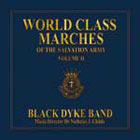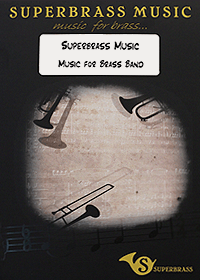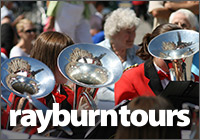 World Class Marches of the Salvation Army: Volume 2
World Class Marches of the Salvation Army: Volume 2
27-Jul-2010
Black Dyke take the well paced orders to provide the latest set of variations on the huge selection from the Salvation Army's march back catalogue.
Black Dyke Band
Conductor: Dr Nicholas Childs
Doyen: DOY CD223
Total playing time: 60.42
Black Dyke follow up their first volume of Salvation Army marches with a second release, most of which date from the 1920’s to 1960’s, with the addition of three of more recent origin.
The excellent sleeve notes are provided by Ronald Holz, which set each march in context, whilst the presentation is well up to the expected standard.
The performances throughout are marked by close attention to dynamics and phrasing, which frequently lifts the readings from being considered mere straightforward run throughs.
Most marches in this collection were intended for use on the streets, and the chosen tempi reflect this.
A new generation
Of the more recent offerings, ‘Dalaro’ (1972) was penned by the then 18-year-old Edward Gregson after he had attended a Salvation Army student conference there, and incorporates a Swedish melody used during the event.
Condon’s ‘Exeter Temple’ (1982) marks the centenary of that West Country corps, and deliberately looks back to stylistic features of the past.
The most recent offering is James Anderson’s ‘Goldcrest’ (1989) which quickly grew in popularity, particularly as a vehicle for use by timbrel brigades.
Originating from Scotland, the composer has long been based in the USA and many American influences can be found.
Performances of the march have frequently featured singing, as by Sellers and a number of youth bands, although Nicholas Childs has declined to get his players to display their vocal prowess, although as a result the reading does comes across as a little strait-laced.
Transatlantic influences
Other transatlantic offerings include two by Emil Söderström, Scandinavian-born but for many years a leading arranger for NBC Radio.
’Army of God’ (1930) was published in the first release of the American Festival Series, and later (1984) reprinted in the General Series at Ray Steadman-Allen’s instigation.
This and the later ‘Minneapolis IV’ (1949) brought numerous American touches to the traditional Salvation Army march, including syncopation, chromatic harmonies and even swing-style scoring.
Transatlantic aspects can also be found in ‘The Roll Call’ (1936) by William Broughton, the grandfather of modern-day composers William and Bruce, which exhibits a directness of approach reminiscent of Sousa and other American writers of his day.
The Antipodes
’The Redcliffe March’ (1929) and ‘The Wellingtonian’ (1925) come from Australia and New Zealand respectively.
Although Ronald Holz points out that the hymn-like trio of the latter was not linked with any particular text, it is frequently used with the words, ‘My Jesus I love Thee’ to good effect.
’Spirit of Joy’ (1957) is one of only two published pieces by another New Zealander, Herbert Rive, but displays considerable skill and mastery of the art.
Marshall & Coles
As one might expect, George Marshall and Bramwell Coles are both represented - the former with ‘The Liberator’ (1923) and ‘Spirit of Praise’ (1933).
The lilting 6/8 ‘Flag of Freedom’ (1924) has retained its popularity over the years, as has the martial ‘Victors Acclaimed’ (1945), the title alluding both to forces personnel returning at the end of the War and the fact that the writer’s seven children had also come through unscathed.
It incorporates the melody from the Sessional Song written for the officer cadets ‘Victors Acclaimed’ training session by Bramwell Coles himself. Lesser known, but equally successful, is his ‘Heroes of the Combat’ (1947).
War-time origins
Another march with war-time origins is Arthur Raikes’ ‘Cairo Red Shield’ (1945), written for the band the writer directed whilst on war service in Egypt. The tune ‘Pilgrims’ is featured in the trio, with a running bass line underpinning the final section.
Herbert Mountain wrote a number of marches, having 15 published in all, but ‘Indomitable’ (1951) is somewhat unusual in following the format of a contest march, with minor key opening, solo cornet feature and dialogue with the rest of the band.
One of the most prolific march writers at present is Norman Bearcroft.
’To Regions Fair’ (1958) was his second to be published, and is another that has become a favourite with timbrel groups, with pointers to his fondness for prominent - and frequently high-lying - euphonium parts.
Concert ending
Completing the collection is Donald Osgood’s ‘Motondo’ (1959), written for an international scout gathering held in Switzerland.
The title comes from an African word meaning “gathering for thanksgiving”, and it includes a favourite song from the event, ‘Travel along in the sunshine’. It is also unusual in having an alternative concert ending.
This is another nicely-varied release to set the feet a-tapping, and there is still scope for more, with plenty of older favourites yet to make an appearance, not to mention later writers such as William Himes, Eiliv Herikstad and Stephen Bulla.
Peter Bale
What's on this CD?
1. The Liberator, 3.17
2. Minneapolis lV, 3.22
3. Dalaro, 3.24
4. Flag of Freedom, 3.04
5. To Regions Fair, 2.38
6. Victors Acclaimed, 4.13
7. Exeter Temple, 4.25
8. Goldcrest, 2.58
9. Motondo, 3.15
10. Army of God, 3.31
11. Spirit of Joy, 2.30
12. The Roll Call, 2.27
13. Indomitable, 2.54
14. The Redcliffe March, 3.25
15. Heroes of the Combat, 3.25
16. Cairo Red Shield, 3.20
17. Spirit of Praise, 3.45
18. The Wellingtonian, 3.25









